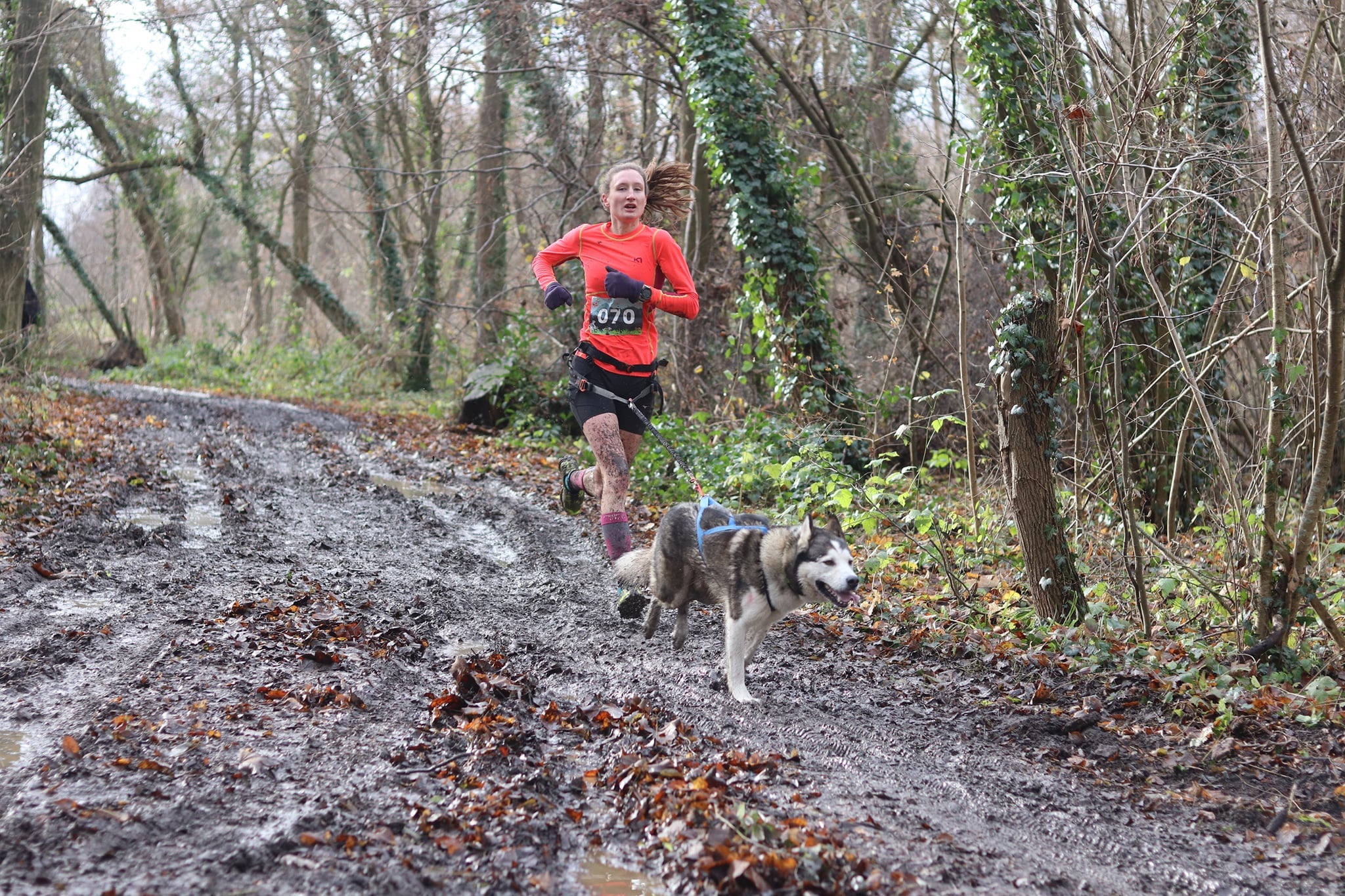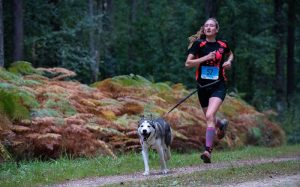“I need teaching my dog to pull because he does not naturally.” You want to do canicross with your dog but he doesn’t pull ? You don’t know how to make him understand what you want from him ? Discover below how to teach your dog to pull in his canicross harness.
If you want general information about canicross, and what you need to know to get started, it’s here.
Many dogs like to pull. This is a relatively easy behavior to obtain most of the time. In fact, learning to walk on a leash without pulling is among the most common issues dog owners face. Dogs naturally walk faster than we do, and it is difficult for them to learn to slow down. Indeed, the dog spontaneously moves rather at a trot, and walking rather than trotting to avoid putting tension on the leash, is not innate.
This is a problem that is not encountered in canicross, since we expect the dog to pull and run ! What can be more difficult to achieve, however, is to have your dog pull even when there is resistance behind him. In fact, we want the dog to understand that he can pull, and that when he meets a resistance, he can insist and pull more.
Teaching your dog to pull : differentiating the contexts
If your dog is very good at walking on lead and has learned not to pull on a leash, it may not be as easy to get him to pull at first. However, this is not at all incompatible ! Indeed, your dog is quite capable of distinguishing between contexts, but also between the different types of equipment you use. Thus, he can continue to walk very well on a leash without pulling on the collar or in his walking harness, but learn to pull with the canicross harness on his back !
Concretely, how to teach your dog to pull?
First, get the right equipment for pulling, so your dog will be comfortable in his harness. You can find some information on canicross equipment here.
Canicross : teaching my dog to pull
Find canicross partners
If your dog doesn’t start pulling on his own, you can try going to a club, or finding training partners. The emulation will undoubtedly motivate your dog and the excitement may also make him forget the elements that could block him. It is also possible to ask someone to run or bike in front of or next to your dog, or even to ask someone to take your dog on a canicross, and to run slightly in front of him yourself, or to precede him on a bike. This can help your dog understand what is expected of him, but it is not to be repeated too often afterwards because we expect our dog to run when WE are attached behind him.
Training intensity and duration of the canicross session
To teach your dog to pull, he must be motivated ! In order to preserve your dog’s will to go, make sure that he has fun during your outings. End the session while your dog is still in shape ! You can continue your outing with your dog free running, but it is preferable to remove his harness so that your dog can distinguish between pulling and going about his business. This way, your dog will associate the canicross harness with pulling.
Canihiking
To teach your dog to pull, you can also start with the cani hiking ! This will allow you to train progressively, to get your dog used to the outings with the equipment. The principle is the same, the equipment too, simply you walk with your dog who pulls you, instead of running. The effort is different for the dog and you. Not necessarily less intense for a dog that pulls a lot even when walking, but for a dog that is a beginner, it can be a good way to get started ! It will also allow you to work more serenely on directions for example.
My dog doesn’t pull: what can I do?
Teaching my dog to pull for canicross
If, despite the above advice, your dog does not pull and turns towards you, or relaxes the lead when he feels the slightest resistance, you can work more specifically.
To teach your dog to pull, alone, here is how you can do it.
Put his canicross harness on your dog. Attach the canicross bungee leash, to your dog’s harness and hold the other end of the leash in your hand. Gently put tension on the leash by pulling it behind your dog, in line with his harness. Do not put strong tension at first. Praise and reward your dog by throwing a reward right in front of him, so he can catch it, but doesn’t have to come back to you to get it.
If you throw the reward too far, move quickly to follow your dog and allow him to take it. This will prevent your dog from being startled by a sudden, tension in the lead. Repeat the exercise, adding a little more tension to the leash, very gradually. You can give your dog a signal when you throw the reward forward. This will allow him to associate the signal with a permission to pull ! For example, you can use the “go” given at the start of a canicross race.
If your dog turns around and comes back to you as soon as you are behind him, you have several options.
If you can get help, ask someone to hold the leash behind your dog. Stand near your dog’s head, praise and reward by tossing the reward right in front of him. You can also tie the lead to a fixed point if you have no one to help you.
Teaching my dog to pull : breaking down the movement
You can also break down the work to teach your dog to pull. This will also help you to teach your dog the ideal position for canicross starts : standing in front of you, with the lead stretched out.
This allows you to take the start alone, without handler, even in bikejoring or dog scooter ! And it is very useful ! Indeed, when your dog doesn’t stay calm at the start, he gets exhausted before the race even begins. He also gets hotter, more pressured, and may show behaviors related to excitement or frustration, which are not desirable.
Having a dog that can hold the line in front of your bike or scooter is also an advantage. It prevents your dog from getting tangled up, or out of his harness for example.
Canicross : teach the “line out” to my dog
Ask your dog for a position he is familiar with, in which he will be least likely to move. The ultimate goal is a standing position, but it is usually easier for dogs to hold a sitting or lying position without moving. Your dog will probably sit in front of you. Mark and reward. Move slightly, on micro step away from your dog. Mark and reward your dog for standing still.
As you train, move further and further away from your dog, towards behind his back. The goal of this step is for your dog to stay still when you are behind him. When this goal is achieved, practice the same by asking your dog to stand. When working with a new position, repeat the steps from the beginning, as it will be more difficult for your dog to stay still while standing up. To reward your dog when you are no longer close enough, come back to him and give him the treat directly. If you throw it, he may have to move to get it, while he is asked to stay still.
Once your dog knows how to stay in front of you, still and standing, practice the same exercise with his canicross harness on. Then with the canicross lead attached to your dog’s harness, the other end of the leash in your hand. Stand behind your dog with the line outstretched but not pulled. Praise and treat.
Repeat the exercise, gradually increasing the tension in the tether. You can then move on to the exercise explained above to teach your dog to pull !
Canicross : my dog still doesn’t pull or doesn’t pull anymore
There are several reasons why your dog may not be pulling. If your dog used to pull but no longer does, check the points below. Perhaps pain or discomfort is disabling him.
Physical causes
If your dog is in pain, or if pulling causes him pain, it is normal that he avoids this behavior. You can do a health check-up with your veterinarian. The animal osteopath is also your best ally ! Indeed, like the human osteopath, the canine osteopath manipulates your dog to analyze its anatomical functioning. Thanks to precise movements, he restores your dog’s body functions. The vast majority of sporting dogs are followed by an osteopath, because sport can also cause trauma. However, it only takes a rough game, a fall or physiological imbalances to require an osteopathic intervention. The results of the animal osteopath’s intervention are often amazing !
Inappropriate harness
Your dog is uncomfortable wearing the harness. If your dog looks uncomfortable in the harness, it may not be a good fit. Check his equipment with a professional if you have the opportunity. Also, check the harness areas yourself to make sure your dog is not injured due to chafing.
Damaged pads
Your dog may have damaged a pad. Check each of his paws. This should be done regularly.
Bad experience
It is also possible that your dog has had a bad experience. In this case, he may have associated canicross with something unpleasant. Try to remember what may have happened, or observe your dog’s behavior for signs of stress. This will allow you to potentially identify the cause of his discomfort, and work specifically to remedy it.
Need help ?
Don’t hesitate to contact me if you have any specific questions, whether it’s about teaching your dog to pull or any other issue !



